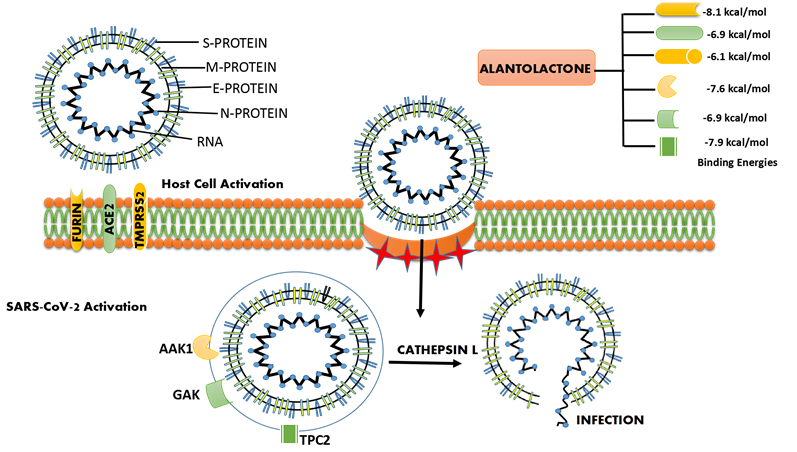Alantolactone: A Potential Multitarget Drug candidate for Prevention of SARS-CoV-2 Cell Entry
Main Article Content
Abstract
The novel strain of coronavirus, SARS-CoV-2, has spread adverse effects on human health with high mortality rates worldwide. SARS-CoV-2 is a severe respiratory disease expressed through positive single stranded RNA enveloped virus. SARS-CoV-2 had affected globally and is influencing the economy as well. The rapidly spreading coronavirus infection has discombobulated the researchers in perpetuate search for different or effective therapeutic drugs. Most of the connatural products are proposed to have significant clinical outcomes but their pathways of action are not clear. This molecular docking study presents alantolactone, a bio-active member of sesquiterpene family as a successful inhibitor of SARS-Cov-2 and human receptor proteins. Alantolactone shows high binding affinity with the SARS-CoV-2 target proteins such as spike glycoprotein (S-protein), nucleocapsid protein (N-protein), main protease (MPro), and papain-like protease (PLPro) with a binding affinity of -7.3 kcal/mol, -7.9 kcal/mol, -6.8 kcal/mol, and -7.1 kcal/mol, respectively as well as human receptor proteins associated with the recognition, binding and biogenesis of SARS-CoV-2 such as angiotensin-converting enzyme 2 (ACE-2), receptor binding domain (S1-RBD) and ACE2 interphase, furin, adaptor-associated protein kinase 1 (AAK1), cyclin G-associated kinase (GAK), and both closed and open configurations of the two-pore channel (TPC2) with binding energies of -6.7 kcal/mol, - 6.9 kcal/mol, -8.1 kcal/mol, -7.3 kcal/mol, and -7.9 kcal/mol, respectively. Molecular docking and ADMET properties and toxicity predictions suggest that alantolactone could effectively binds with various viral target protein and human target proteins and could be developed into a novel SARS-coV-2 inhibitor.
Downloads
Article Details

This work is licensed under a Creative Commons Attribution-ShareAlike 4.0 International License.
Authors continue to retain the copyright to the article if the article is published in the Journal of Molecular Docking. They will also retain the publishing rights to the article without any restrictions.
Authors who publish with this journal agree to the following terms:
- Any article on the copyright is retained by the author(s).
- The author grants the journal, right of first publication with the work simultaneously licensed under a Creative Commons Attribution License that allows others to share work with an acknowledgment of the work authors and initial publications in this journal.
- Authors are able to enter into separate, additional contractual arrangements for the non-exclusive distribution of published articles of work (eg, post-institutional repository) or publish it in a book, with acknowledgment of its initial publication in this journal.
- Authors are permitted and encouraged to post their work online (e.g., in institutional repositories or on their websites) prior to and during the submission process, as can lead to productive exchanges, as well as earlier and greater citation of published work.
- The article and any associated published material are distributed under the Creative Commons Attribution-ShareAlike 4.0 International License.
References
To be published




